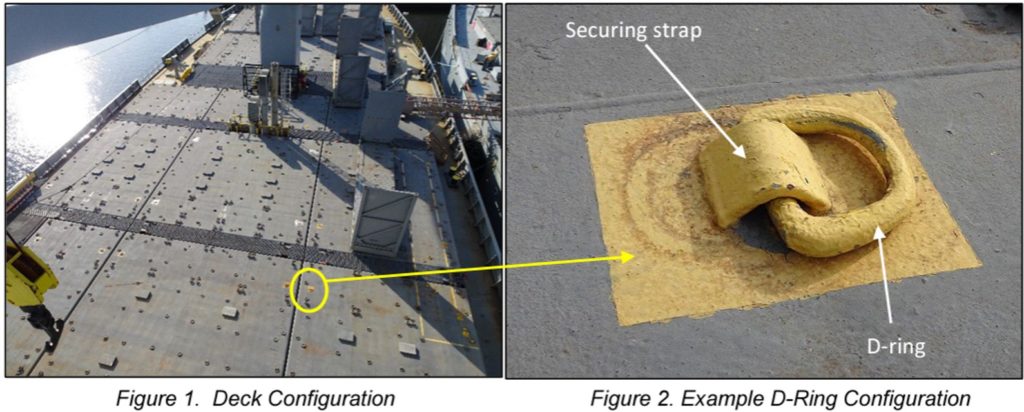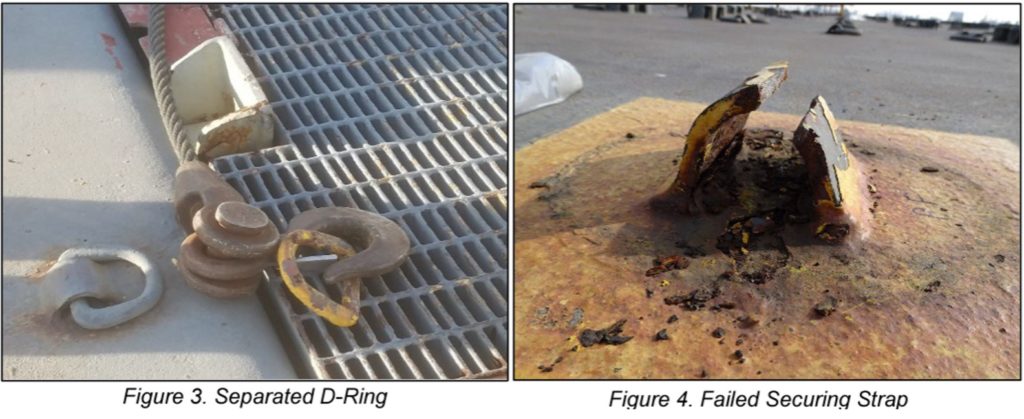USCG: Hidden corrosion on deck fittings can cause dangerous failures
The United States Coastguard (USCG) has published Safety Alert 09-22 relating to a dangerous and potentially fatal situation involving D-ring lifting points, which caused a severe injury to a crewmember.
What happened While positioning a removable hatch cover on the vessel (Figures 1 and 2), three of the four D-ring securing straps failed (Figures 3 and 4), causing an uncontrolled snap-back of the lifting sling assembly that struck the crewmember in the head. The three fractured securing straps showed similar failures with a significant amount of corrosion beneath the paint and on the underside of the straps. It is likely that just one D-ring failed initially, which would have instantly doubled the load on the two adjacent corner D-rings, both of which were apparently weakened and subsequently failed. Without proper and periodic inspection and replacement, corrosion and stress can eventually lead to deck fitting failures.
What went wrong


- Whilst the arrangement of the hatch cover lifting points were in accordance with all available drawings and design schematics, there were no records of any pull-tests or other testing conducted on these lifting points since their installation in the mid-1980s;
- There were no records of any D-ring replacements, indicating that these have likely been in an exterior weather deck environment for several decades;
The Coastguard recommend that vessel owners, operators, and other maritime stakeholders:
- Immediately identify high-risk D-rings and similar lifting-point fittings. High risk factors include: Age, weather exposure, and lifting load. These factors will cumulatively cause corrosion losses on the fitting, increasing its stress and fatigue vulnerability during each lifting cycle;
- Thoroughly inspect all high-risk lifting points for damage, hidden corrosion, and wastage. Audio gauging, pull-testing, or even replacement may be appropriate;
- Consult with the manufacturer’s instructions to ensure safe lifting limits are in place and that the effects of service life are considered in their determination;
- Establish a maintenance schedule for periodically inspecting all lifting points and audio gauging or testing any fittings as they age into high-risk status.
The USCG encourages marine inspectors, investigators, and surveyors to maintain an acute awareness of these issues and initiate corrective actions as needed.
Members may wish to refer to:
Safety Event
Published: 10 November 2022
Download: IMCA SF 25/22
IMCA Safety Flashes
Submit a Report
IMCA Safety Flashes summarise key safety matters and incidents, allowing lessons to be more easily learnt for the benefit of all. The effectiveness of the IMCA Safety Flash system depends on Members sharing information and so avoiding repeat incidents. Please consider adding [email protected] to your internal distribution list for safety alerts or manually submitting information on incidents you consider may be relevant. All information is anonymised or sanitised, as appropriate.
IMCA’s store terms and conditions (https://www.imca-int.com/legal-notices/terms/) apply to all downloads from IMCA’s website, including this document.
IMCA makes every effort to ensure the accuracy and reliability of the data contained in the documents it publishes, but IMCA shall not be liable for any guidance and/or recommendation and/or statement herein contained. The information contained in this document does not fulfil or replace any individual’s or Member's legal, regulatory or other duties or obligations in respect of their operations. Individuals and Members remain solely responsible for the safe, lawful and proper conduct of their operations.
